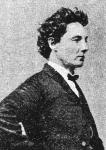Born: Established: 1834 ; Died: Ceased: 20 Jun 1909 Sydney, New South Wales,
AustLit
BiographyHistory
Most Referenced Works
Notes
-
1. HISTORICAL NOTES AND CORRECTIONS:
1.1. Among the other leading Australian scenic artists of the late nineteenth century were William Pitt, P. M. Tannett, John Hennings, J. R. Setright, Andrew Torning, Charles Fry, John Little, Harry Grist, Alfred Clint, Henry Holmes, W. B. Spong, Harry Whaite, and Alfred Tischbauer ('Alta').
1.2. It is unclear if the actor billed as 'Mr Wilson' in George Fawcett Rowe's Theseus and Ariadne (Royal Princess Theatre, Melb; 1863) is W. J. Wilson or C. Wilson (the latter actor is appeared in a number of productions in Melbourne during the 1860s).
1.3. Frank Hawthorne: Several reports published between 1894 and 1928 draw attention to Wilson and Hawthorne being father and son. See, for example, Sydney Morning Herald (17 Feb. 1894, p.5 and 7 Sept. 1895, p.4) and Everyone's (12 Dec. 1928, p.131).
1.4. One of Wilson's sons, W. Wilson Jnr also turned his hand to scenic art. Among his known productions was George Darrell's The New Rush (Bijou, Melb; 27 Dec. 1886).
1.5. Another son, Carden Wilson, was a well-known vaudeville artist who specialised in mimicry.
-
2. SCENIC ART (PRODUCTIONS):
The following list comprises stage productions with scenic art by W. J. Wilson that have been identified to date:
1857: Harlequin Whittington and His Cat (Theatre Royal, Melbourne, 26 Dec.) with William Pitt and Charles Fry.
1858: Harlequin Robin Hood (Theatre Royal, Melbourne, 27 Dec.) with P. M. (or B.) Tannett and Alexander Habbe.
1859: The Yellow Dwarf (Theatre Royal, Melbourne, 25 Apr.) with William Pitt and Alexander Habbe.
1861: The Woman in White (Lyceum, Sydney, 29 Oct.).
1862: Rangatira Wahena (Lyceum, Sydney, 28 July) ; Haie Waikonaitai (Lyceum, Sydney, 21 Sept.).
1863: The Haunted Chamber (Prince of Wales, Sydney 10 Sept.) with C. W. Barry.
1864: The Duke's Motto (Prince of Wales Theatre, Sydney, 28 Apr.) ; Harlequin King Gander and Mother Goose (Prince of Wales Theatre, Sydney, 26 Dec.).
1865: High-Low-Jack-Game (Royal Victoria, Sydney, 16 Jan.).
1869: The Model Husband (Royal Adelphi, Sydney, 27 Nov.) with Alexander Habbe [aka A Lesson for Husbands] ; Love's Silver Dream (Royal Adelphi, Sydney, 24 Dec.) with Alexander Habbe.
1870: Conrad the Corsair (Royal Adelphi, Sydney, 12 Feb.), Prometheus (Royal Adelphi, Sydney, 7 May), Two Lovers (Royal Adelphi, Sydney, 11 June), all with Alexander Habbe ; The Three Bears and Little Silverhair the Charming (Royal Victoria Theatre, Sydney, 24 Dec.).
-
1871: The House that Jack Built (Prince of Wales, Sydney, 23 Dec.) with Alfred Clint.
1872: Euchred (23 Mar.) ; Butcher Baronet (12 June) ; Prince Dorus (22 June) ; Wanted 100,000 Milliners for the Gulgong Gold Diggings (29 June) ; The Darrells at Home (15 July) with Alfred Clint ; Hazard: Or, Pearce Dyceton's Crime (15 July) with Alfred Clint ; Foiled (10 Aug.) ; The Yellow Dwarf and the King of Hawkins Hill Gold Mines (26 Dec.) [all Royal Victoria Theatre, Sydney].
1873: Gold (Queen's Theatre, Sydney, 25 Oct.) ; Harlequin Man in the Moon (Queen's Theatre, Sydney, 24 Dec.).
1874: Oliver Twist (24 Jan.) ; Ups and Down: Or, Uncle Thomas' Money (29 Jan.) ; Caste (14 Feb.) ; Friends of the Flag (30 Nov.) ; Robinson Crusoe (26 Dec.) [all Queen's Theatre, Sydney].
1875: Hazard: Or, Pearce Dyceton's Crime (Queen's Theatre, Sydney 23 Aug.) ; Beauty and the Beast (Theatre Royal, Sydney 27 Dec.) with William Kinchella and Alfred Clint.
-
1877: The Struggle for Freedom (23 Mar.) ; Humpty Dumpty (Who Sat on the Wall) (Syd; 26 Dec.) [all Theatre Royal, Sydney].
1878: Back from the Grave (2 Mar.) ; The Struggle for Freedom (23 Mar.) ; The Scarlett Letter (29 June) [all Theatre Royal, Sydney].
1879: Hey Diddle Diddle the Cat and the Fiddle, the Cow Jumped Over the Moon (25 Feb.) ; Babes in the Wood (Theatre Royal, Sydney; 26 Dec.) [all Theatre Royal, Sydney].
1880: The Forlorn Hope (Queen's Theatre, Sydney, 10 July) with William Kinchella.
1881: H.M.S. Pun-no-Fear (Opera House, Sydney, 21 May).
1883: The Sunny South (Opera House, Sydney, 22 Dec.) with Alfred Clint.
1888: Sinbad the Sailor (Theatre Royal, Melbourne, 26 Dec.) with George Gordon, John Brunton and James Peake.
1890: Moths (Garrick Theatre, Sydney, 23 Dec.) with W. B. Spong.
1891: Black-Eyed Susan (Garrick Theatre, Sydney, 25 Apr.).
-
Entries connected with this record have been sourced from historical research into Australian popular theatre conducted by Dr Clay Djubal.
-
4. FURTHER REFERENCE:
Sydney Morning Herald: 20 Dec. 1890, pp.2, 10 [re. Garrick Theatre] / 23 October 1895, p.8 [re. Wilson's benefit - see also 1 June, p.10; 12 Oct., p.9; 19 Oct., p.10; and 22 Oct., p.6].
Thorne, Ross. Theatre Buildings in Australia (1971), pp.198-201, and Appendix O, p.41 [re: Garrick Theatre].


